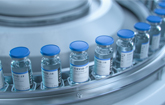Reportlinker Adds Enzymes in Drug Manufacturing
NEW YORK, April 4, 2011 /PRNewswire/ -- Reportlinker.com announces that a new market research report is available in its catalogue:
http://www.reportlinker.com/p0470173/Enzymes-in-Drug-Manufacturing.html
Biocatalysis in pharmaceutical manufacturing is being driven by advances in enzyme and genomics technologies that are increasing the breadth of reaction applicability. The environmental benefits of enzymatic catalysis are also a strong influence.
This report examines the benefits and challenges of implementing enzymatic steps in pharmaceutical manufacturing. It covers why enzymes are central to green chemistry and industrial biotechnology. The range of industrial enzymes and sources of innovation are covered, along with numerous case studies of enzymes being successfully employed.
Scope of this research
- Understand why biocatalysis plays a central role in the emerging trend toward green chemistry.
- Appreciate the power of enzymes in controlling the formation of chiral products.
- Learn of the techniques employed to develop non-natural enzymes that are better suited to industrial processes.
- Examine case studies in which enzymes have provided significant benefits during process development and optimization efforts. Identify the likely sources of future advances in developing novel enzymatic catalysis processes.
Research and analysis highlights
Enzymes can replace conventional catalysts in drug manufacturing and give significant gains in terms of reduced raw materials and other inputs by improving efficiency and allowing reactions to take place under milder conditions. Biocatalytic steps often offer a powerful solution to the problem of controlling stereochemistry.
Both green chemistry and industrial biotechnology are important emerging trends worldwide. Enzymes are central to both disciplines so developments are likely to increase the focus on biocatalysis and encourage its wider implementation within industry.
There are many potential sources of innovative enzymes that could meet the needs of pharma. These include organisms from extreme environments and genomic databases. New and old enzymes can be optimized for their properties using technologies such as directed evolution.
Key reasons to purchase this research
- What benefits do enzymes offer compared with conventional chemical synthesis?
- How can an enzymatic steps be integrated into an existing manufacturing process and what are the challenges in so doing?
- Why are enzymes such a key focus in both green chemistry and industrial biotechnology?
- How can a natural enzyme be modified so that its properties are compatible with process conditions typically found in the pharmaceutical industry?
- What sectors of industry currently make the best use of enzymes in their processes and can pharma follow suit?
Table of Contents
About the author 2
Disclaimer 2
Executive summary 11
Introduction 11
Industrial biotechnology 11
Green chemistry in drug manufacturing 12
Enzymes and the enzyme industry 13
Overview of the use of enzymes in drug manufacturing 13
Case histories of biocatalysis 14
Industrial enzymes from extremophiles 15
The way forward 16
Enzyme companies and their products 17
Chapter 1 Introduction 18
Summary 18
Introduction 18
Technical advantages of biocatalysis 21
Expanding the enzyme toolkit 23
Genome and metagenome databases 23
Enzyme engineering and directed evolution 24
Host expression technology 24
Pathway engineering 25
Synthetic biology 25
Regulatory changes favoring biocatalysis 25
Introduction to stereochemistry 26
Structural isomerism 27
Stereoisomerism 28
Cis-trans isomerism 28
Enantiomerism 29
Diastereoisomerism 30
Important functional groups in medicinal chemistry/drug manufacturing 32
The history of the use of enzymes in drug manufacturing 33
Chapter 2 Industrial Biotechnology 34
Summary 34
Introduction 34
Defining industrial biotechnology 35
Enzymes 36
A growing market 37
Government initiatives 38
The US and IB 39
Europe and IB 40
IB – the future 43
Norway – from blue to white biotech 44
Focus on Russia 45
Chapter 3 Green chemistry in drug manufacturing 47
Summary 47
Introduction 47
The growth of green chemistry 48
Enzymes and the rules of green chemistry 49
Green chemistry and big pharma 50
Green chemistry and catalysts 51
Green chemistry infrastructure 53
CoEBio3 53
The Green Chemistry Centre for Industry 55
Drivers and barriers to widespread adoption of green chemistry 55
Patent protection 56
Environmental regulation 57
Education 57
Presidential Green Challenge 57
Green chemistry and vitamin C synthesis 58
Chapter 4 Enzymes and the enzyme industry 60
Summary 60
Introduction 60
The enzyme tool kit 62
Metagenomics 64
Sequence-based discovery 65
Improving on nature's enzymes for industry 65
Rational enzyme design 66
Directed evolution 66
Case study – Lipitor 67
Chapter 5 Overview of the use of enzymes in drug manufacturing 69
Summary 69
Introduction 70
Implementing biocatalysis in drug manufacturing 70
Using enzymatic resolution 73
Enzymes with a track record in the chemical pharmaceutical industry 74
Lipases 75
Oxidoreductases 76
Nitrilases 78
Epoxide hydrolases 78
Hydroxynitrile lyases 78
Aldolases, glycosidases, and glycosyltransferases 79
Amidases 80
The synthesis of chiral amines 80
A comparison of chemical and biocatalysis routes 81
Chapter 6 Case histories of biocatalysis 82
Summary 82
Introduction 83
Specific case studies 83
Pregabalin 83
Aliskiren 84
Posaconazole 85
Ribavirin 86
Beta-lactam antibiotics 87
Biocatalysis in GW's antiviral program 88
Lamivudine 88
Zanamavir 89
Indinavir 91
Aprepitant 92
Paroxetine 92
Levetiracetam 92
Examples of whole-cell biotransformations in drug manufacturing 92
Chapter 7 Industrial enzymes from extremophiles 96
Summary 96
Extremophiles – a largely unexplored resource for industry 97
Case history of a potential industrial enzyme 100
Examples of extremozymes for the pharmaceutical industry 100
The future of extremophile research and its applications 104
Chapter 8 The way forward 106
Summary 106
Introduction 107
Reducing waste 108
A whole-industry approach 108
Making more enzyme tools available 109
Enzymes for pharma – a growing market? 110
Chapter 9 Enzyme companies and their products 112
Summary 112
Introduction 113
Aquapharm Biodiscovery (Oban, UK) 114
ArcticZymes AS (Tromso, Norway) 115
Codexis (Redwood City, CA) 115
DSM Pharmaceutical Products (Parsippany, NJ) 116
Dyadic International Inc (Jupiter, FA) 117
Genecor (Copenhagen, Denmark) 117
Novozymes (Bagsvaerd, Denmark) 118
Specialty Enzymes and Biotechnologies (Chino, CA) 119
ZyGEM Corporation (Hamilton, New Zealand) 119
Appendix 120
Scope 120
Methodology 120
Primary research 120
Secondary research 120
Glossary/Abbreviations 121
References 122
Other sources 127
Table of figures
Figure 1: Illustration of structural isomerism 28
Figure 2: Illustration of cis-trans isomerism 29
Figure 3: Illustration of enantiomerism 29
Figure 4: Illustration of diastereoisomerism 31
Figure 5: Main principles of green chemistry 49
Figure 6: Green chemistry drivers and barriers 56
Figure 7: Synthetic biocatalytic route to vitamin C 58
Figure 8: BASF process for producing chirally pure amines 75
Figure 9: Enzymatic resolution using an esterase en route to aliskiren 85
Figure 10: Enzymatic resolution of a racemic alcohol using a lipase 87
Figure 11: Enzymatic steps in the production of zanamavir 91
Figure 12: Challenges and opportunities for extremophiles 105
Table of tables
Table 1: Top 20 pharmaceutical products in the market by sales ($bn), 2009 21
Table 2: Chemical sales by segment, 2007–2012 38
Table 3: White biotech industry growth, 2007–2012 38
Table 4: US biobased chemicals penetration of global market (%), 2010–2025 39
Table 5: Enzymes used in drug manufacturing 73
Table 6: Enzymes often used in resolution processes 74
Table 7: Commercial drugs using biotransformation processes 95
Table 8: Categories of extremophiles 98
Table 9: Examples of extremozymes 104
Table 10: Revenues of leading enzyme companies 114
To order this report:
Check our Company Profile, SWOT and Revenue Analysis!
CONTACT:
Nicolas Bombourg
Reportlinker
Email: [email protected]
US: +1-805-652-2626
Intl: +1-805-652-2626
SOURCE Reportlinker
WANT YOUR COMPANY'S NEWS FEATURED ON PRNEWSWIRE.COM?
Newsrooms &
Influencers
Digital Media
Outlets
Journalists
Opted In




Share this article